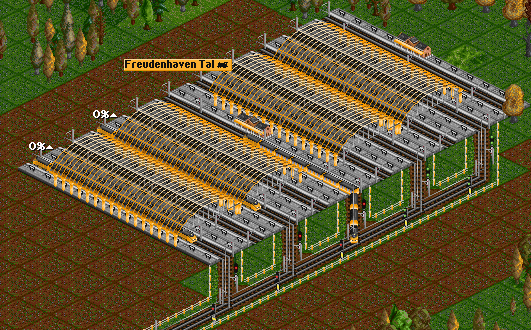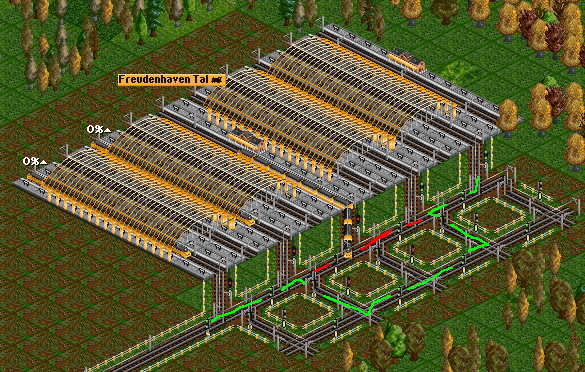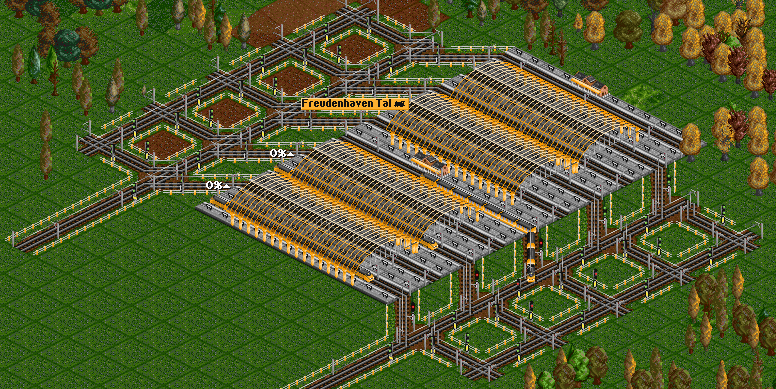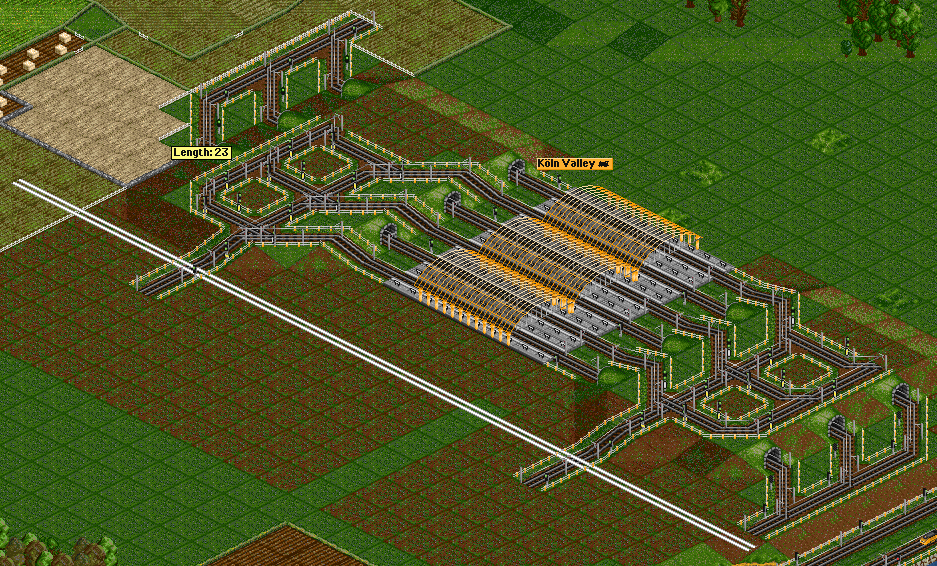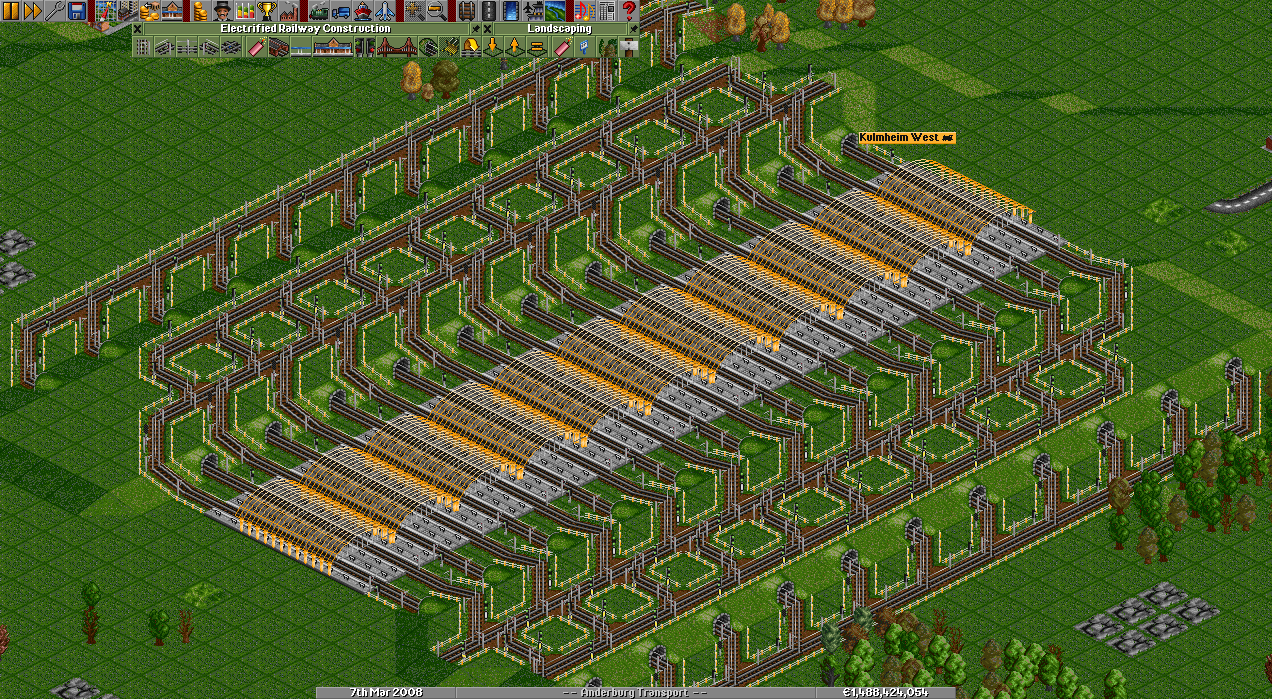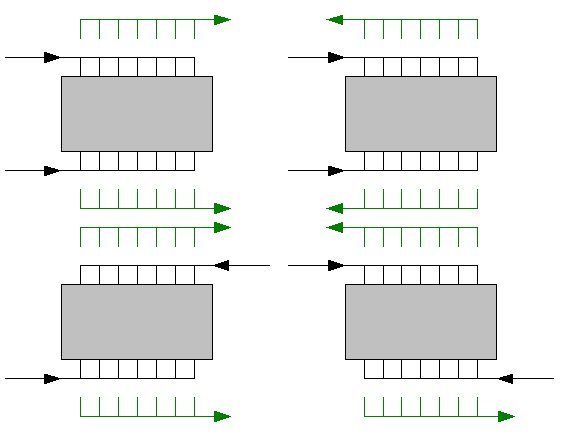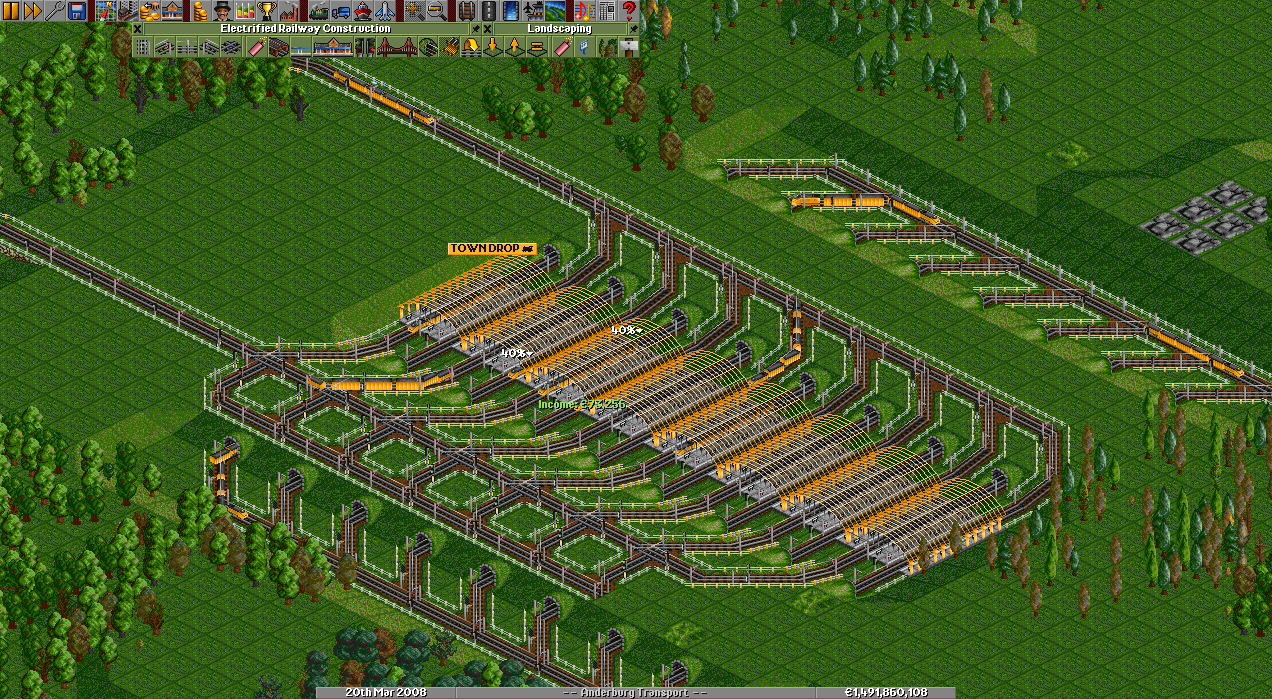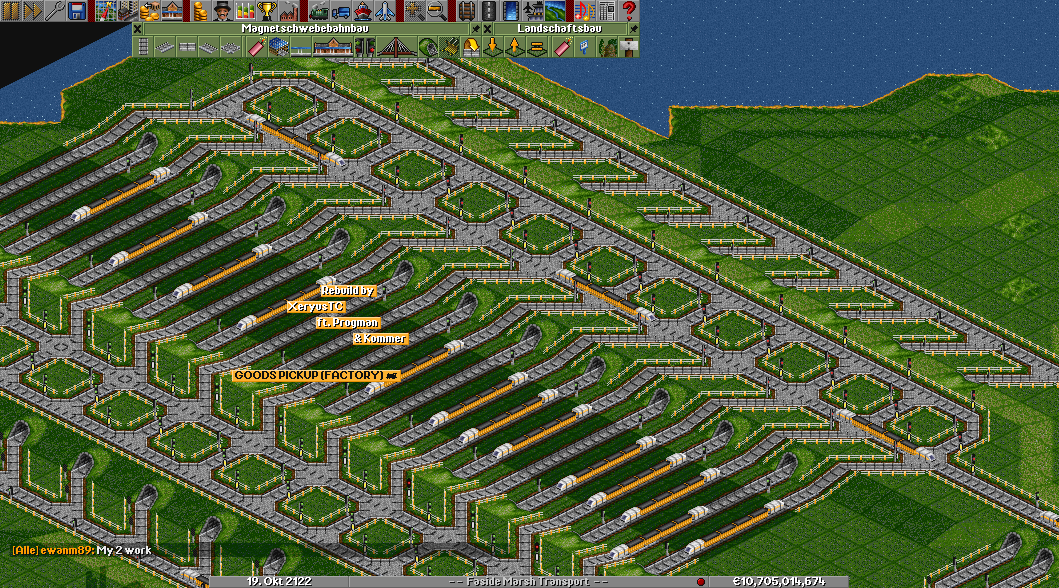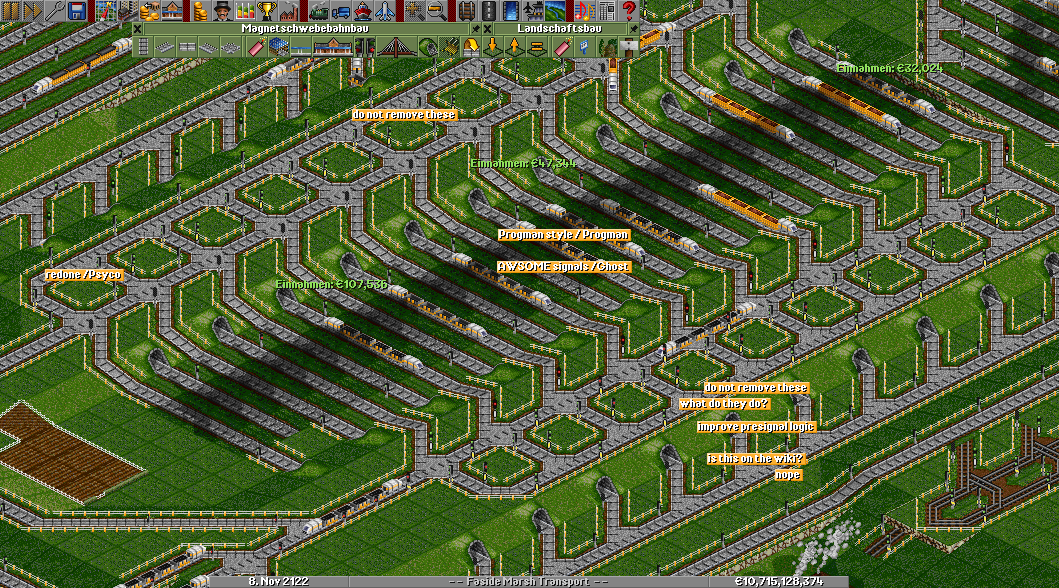Difference between revisions of "Presignal Bypass Station"
From #openttdcoop wiki
m (User:Progman/Draft Station moved to Presignal Bypass Station) |
m (Addde to advanced networking category) |
||
| (4 intermediate revisions by 3 users not shown) | |||
| Line 1: | Line 1: | ||
| − | + | Building a large station, as is needed for pickups and drops for secondary industries, is a difficult task. There are many challenges due to the large capacity. The station must have sufficient flow to prevent jamming. Cities, industries, and other landmarks provide boundaries to a desired station layout. | |
| + | |||
| + | A typical secondary station consists of about 20 platforms and is served by a [[Mainline|ML]] of 3-4 tracks. It requires a lot of skill to build a proper joiner after the station and it is even more difficult to build a splitter to allow the trains to efficiently access the platforms. This complexity typically requires lots of bridges, tunnels, and presignals. | ||
==The Idea== | ==The Idea== | ||
| − | + | This idea proposes a station that can be extended from a small-scale station to a much larger-scale station by adding platforms in the same pattern, without needing to completely redesign the station as its capacity grows. The station is turned by 90 degrees relative to the track the trains come from. The trains pass through the station until they find a free spot, and then enter it. If the traffic is too heavy, the station can be extended with more platforms. After adding presignals, it works... for slow traffic. As a train in the presignal area will block the whole presignal block, other trains have to wait at the beginning, even if there are a lot of slots free. | |
[[Image:Blocking the presignal area.png]] | [[Image:Blocking the presignal area.png]] | ||
| − | As you see the train | + | As you see, the train entering the station blocks the other train from joining the last slot. So I thought about some presignal stuff which transports the information "slot is free" from the slots at the end to the presignal at the beginning. I did this with a second line, similar to [[priorities]]. |
[[Image:Second presignal line.png]] | [[Image:Second presignal line.png]] | ||
| − | Notice how the free-slot information | + | Notice how the free-slot information "travels" through the marked tiles around the train which blocks a segment. With these presignals, a new train can enter the presignals even if there already a train entering the platform. |
==How to improve the layout== | ==How to improve the layout== | ||
| − | + | Only a half of station's platforms are used and cannot be used from this side as the complex signaling blocks the entry. But they can be used from the other side. | |
[[Image:Use the other side.png]] | [[Image:Use the other side.png]] | ||
| − | + | For an exit, the trains can go through tunnels under the presignal logic for the opposite entry. | |
[[Image:Station layout with tunnels.png]] | [[Image:Station layout with tunnels.png]] | ||
| − | If the trains leave the station they have | + | If the trains leave the station, they have enough space in the tunnel to wait if the exit isn't free yet. You can see the exit from the upper part goes east, the exit from the lower part goes west. This can be flipped/switched however you need it. You also see a disadvantage of this layout. This station and all tracks and signals with a TL of 5 are 23 tiles width. You need around 18+TL tiles space for the width. But - and thats the advantage - you can extend this layout as long as you need. |
[[Image:Full station with a lot of slots.png]] | [[Image:Full station with a lot of slots.png]] | ||
| − | You see here again you can choose from where the trains | + | You see here again you can choose from where the trains come and where they go. This can be changed as whatever you want. |
[[Image:Station diagramm layout.png]] | [[Image:Station diagramm layout.png]] | ||
| Line 38: | Line 40: | ||
[[Image:Station goods drop ottdcoop.png]] | [[Image:Station goods drop ottdcoop.png]] | ||
| + | |||
[[Image:Station coal_ore drop ottdcoop.png]] | [[Image:Station coal_ore drop ottdcoop.png]] | ||
| − | [[Category: | + | |
| + | [[Category:Stations]] | ||
| + | [[Category:Advanced Networking]] | ||
Latest revision as of 10:56, 4 December 2013
Building a large station, as is needed for pickups and drops for secondary industries, is a difficult task. There are many challenges due to the large capacity. The station must have sufficient flow to prevent jamming. Cities, industries, and other landmarks provide boundaries to a desired station layout.
A typical secondary station consists of about 20 platforms and is served by a ML of 3-4 tracks. It requires a lot of skill to build a proper joiner after the station and it is even more difficult to build a splitter to allow the trains to efficiently access the platforms. This complexity typically requires lots of bridges, tunnels, and presignals.
The Idea
This idea proposes a station that can be extended from a small-scale station to a much larger-scale station by adding platforms in the same pattern, without needing to completely redesign the station as its capacity grows. The station is turned by 90 degrees relative to the track the trains come from. The trains pass through the station until they find a free spot, and then enter it. If the traffic is too heavy, the station can be extended with more platforms. After adding presignals, it works... for slow traffic. As a train in the presignal area will block the whole presignal block, other trains have to wait at the beginning, even if there are a lot of slots free.
As you see, the train entering the station blocks the other train from joining the last slot. So I thought about some presignal stuff which transports the information "slot is free" from the slots at the end to the presignal at the beginning. I did this with a second line, similar to priorities.
Notice how the free-slot information "travels" through the marked tiles around the train which blocks a segment. With these presignals, a new train can enter the presignals even if there already a train entering the platform.
How to improve the layout
Only a half of station's platforms are used and cannot be used from this side as the complex signaling blocks the entry. But they can be used from the other side.
For an exit, the trains can go through tunnels under the presignal logic for the opposite entry.
If the trains leave the station, they have enough space in the tunnel to wait if the exit isn't free yet. You can see the exit from the upper part goes east, the exit from the lower part goes west. This can be flipped/switched however you need it. You also see a disadvantage of this layout. This station and all tracks and signals with a TL of 5 are 23 tiles width. You need around 18+TL tiles space for the width. But - and thats the advantage - you can extend this layout as long as you need.
You see here again you can choose from where the trains come and where they go. This can be changed as whatever you want.
Thats how it looks in a real game
And that is how it looks on a real game in an openttdcoop-game
